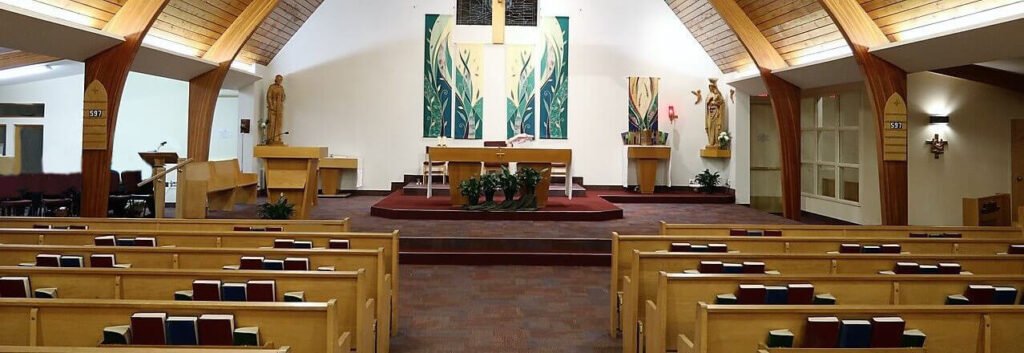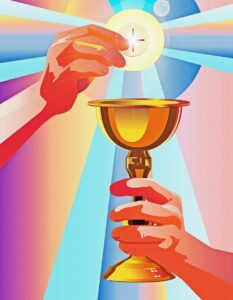

Our Lady of Perpetual Help
4588 Roblin Blvd, Winnipeg MB R3R 0G4
(204) 832-1993
Welcome to our Parish
Our Lady of Perpetual Help Parish seeks to reflect God’s love and life. A people, members of the Body of Christ, disciples on a journey. We are young and old. We are shepherds who are sheep and sheep who are shepherds. We are seekers of Love and Life. We are a home, and the Lord, who lives here, welcomes you. Our Lady protects all of us, always.
Office Hours
Weekdays: 9 am to 3 pm
Weekends and Holidays: Closed
Weekend Mass times
Saturday: 5 PM
Sunday: 9 and 11 AM
Upcoming Masses
More Connections

ATTENDING A CATHOLIC MASS FOR THE FIRST TIME?
Are you attending a funeral, a wedding, or just wondering? If you have never attended a Mass in a Roman Catholic church, the experience may or may not be somewhat familiar, depending on your background. For someone who has been raised in the Eastern Orthodox tradition, understanding the tradition of the Mass will not be a big step. On the other hand, the experience may completely unfamiliar.
Here are some tips if you are attending Mass for the first time…
1. Turn up in good time.
If you don’t want to feel stressed, do yourself a favour and turn up a little early. Doing this will give you a chance to find a seat, settle in, and take in your new surroundings. Use the time to calm your soul.
Oh, and don’t forget to turn off your phone as you enter the Church. Having it go off unexpectedly will surely draw attention.
2. You won’t understand everything, but that’s okay.
The Mass is steeped in 2,000 years of Christian theology and practice, and this itself rests on the even older foundation of Judaism. Things initially may be hard to understand. Symbols are often used. For instance you might see burning incense, which is symbolic of our prayers rising to God. If you keep coming back each week and start digging into the roots of the Mass, it will all start to make sense and you’ll come to discover the richness found there.
3. Mass follows a script.
You will soon notice that there’s a “script” for Mass that is used worldwide. The priest and the people have prescribed parts. The priest will say something (e.g. “The Lord be with you!”) and then all the people will respond in unison (e.g. “And with your spirit”).
4. Expect some physical movement.
God made us body and soul. Therefore, at Mass we don’t just think pious thoughts, we also worship with our bodies. This means that we stand to hear the words of Christ proclaimed, we sit to listen to the priest’s homily and we kneel in prayer during the Consecration and after Communion.
5. Don’t worry about doing something wrong.
Being apprehensive about doing something new is normal. Just follow what others around you are doing. Sit when everyone else sits and stand when they stand.
The only point in the Mass where you’ll actually have to do anything is when the Priest invites you to turn to the person next to you “and offer one another a sign of peace”. Typically this just involves shaking your neighbour’s hand or nodding in acknowledgement.
If you want to follow along with the congregation’s responses, they are available in the “missal”, a book which is typically found in the pews. However, it is more advantageous for newcomers to listen to the words being said.
6. Two halves.
The Mass is divided into two parts: the Liturgy of the Word and the Liturgy of the Eucharist. The former part is devoted to prayer, the reading of Sacred Scripture and the priest’s homily, which is his reflection on the Bible passages which have just been read. The latter part of the Mass focuses on Holy Communion, or as it is more commonly called, The Eucharist. If you’ve been to a Protestant service, the first part of the Mass will probably seem reasonably familiar, but the second half maybe less so.
7. Jesus in the Eucharist.
Unless you understand the Catholic belief about the Eucharist, much of this part of the Mass may be difficult to comprehend…
So what is the Eucharist? Well, in the part of the Mass known as “The Offertory Procession”, bread and wine are brought forward and placed on the altar. Catholics believe that, by the authority of Christ, when the priest calls down the Holy Spirit upon the bread and wine (mixed with water), while the appearance of bread and wine remain, they are transformed into Jesus’ Body and Blood. By consuming them, we are filled with the Divine Life.
Understanding the Eucharist illuminates so much of what might be confusing about the Mass. This is why Catholics take the Mass so seriously. This is why we fast from food beforehand. This is why Catholics kneel after Communion and why we bow towards the tabernacle, the container close to the altar, which contains the Eucharist.
8. What to do during Communion.
Since Catholics believe that Jesus is truly present in the bread and wine, we take the receiving of Holy Communion very seriously. As a result, Communion is restricted to practicing Catholics. Since you won’t be able to receive Communion, you have a couple of options:
(a) Stay put
You can simply stay where you are and people will move past. You can also move out of the pew to make it easier for others in your row to go to Communion. While they are receiving the Eucharist, if you would like, you can make a “spiritual communion” by simply praying the following prayer in your pew:
“My Jesus, I believe that You are present in the Most Holy Sacrament [of the Eucharist]. I love You above all things, and I desire to receive You into my soul. Since I cannot at this moment receive You sacramentally, come at least spiritually into my heart. I embrace You as if You were already there and unite myself wholly to You. Never permit me to be separated from You. Amen”
(b) Go up
Alternatively, you can actually join the Communion line in order to receive a blessing from the priest. You do not have to be Catholic or even a Christian to receive a blessing. You indicate that you wish to receive a blessing by crossing your arms across your body, when you are in front of the priest.
9. Don’t be afraid to ask questions.
Do not be afraid to identify yourself as a visitor! Say “Hello” to the priest – he will be easy to spot. If you were confused or curious about anything you experienced at Mass, don’t be afraid of asking questions and don’t worry if you think they might be “too basic”.
If you are interested in learning more about the Catholic Church, you might ask about signing up for RCIA (The Rite of Christian Initiation of Adults), which is a course that you can freely attend to learn more questions about the Catholic Faith.
Adapted from: Pilgrim. “Attending a Catholic Mass for the First Time?” Restless Pilgrim, 16 June 2018, https://restlesspilgrim.net/blog/2018/06/16/attending-mass/. Used with permission.








